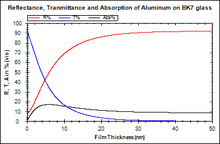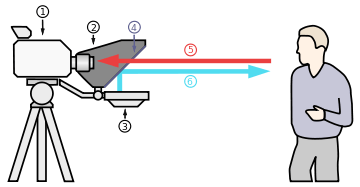One-way mirror

A one-way mirror, also called two-way mirror[1] (or two-way glass) and semi-transparent mirror, is a reciprocal mirror that is partially reflective and partially transparent. The perception of one-way transmission is achieved when one side of the mirror is brightly lit and the other side is dark. This allows viewing from the darkened side but not vice versa.
History
The first US patent for a one-way mirror appeared in 1903, then named a "transparent mirror".[2][3]
Principle of operation

The glass is coated with, or has encased within, a thin and almost-transparent layer of metal (usually aluminium). The result is a mirrored surface that reflects some light and is penetrated by the rest. Light always passes equally in both directions. However, when one side is brightly lit and the other kept dark, the darker side becomes difficult to see from the brightly lit side because it is masked by the much brighter reflection of the lit side.[4]
Applications

A one-way mirror is typically used as an apparently normal mirror in a brightly lit room, with a much darker room on the other side. People on the brightly lit side see their own reflection—it looks like a normal mirror. People on the dark side see through it—it looks like a transparent window. The light from the bright room reflected from the mirror back into the room itself is much greater than the light transmitted from the dark room, overwhelming the small amount of light transmitted from the dark to the bright room; conversely, the light reflected back into the dark side is overwhelmed by the light transmitted from the bright side. This allows a viewer in the dark side to observe the bright room covertly.
When such mirrors are used for one-way observation, the viewing room is kept dark by a darkened curtain or a double door vestibule. These observation rooms have been used in:
- Execution rooms
- Experimental psychology research
- Interrogation rooms
- Market research
- Reality television, as in the series Big Brother, which makes extensive use of one-way mirrors throughout its set to allow cameramen in special black hallways to use movable cameras to film contestants without being seen.[5]
- Security observation decks in public areas
- Train driver or conductor compartments in newer metro trains, such as Bombardier Transportation's Movia family of metro trains, including the Toronto Rocket
Smaller versions are sometimes used in:
- Low-emissivity windows on vehicles and buildings
- Mobile phone and tablet screen covers, enabling the screen to be used as a mirror when it is off
- Security cameras, where the camera is hidden in a mirrored enclosure
- Stage effects (particularly Pepper's ghost)
- Teleprompters, where they allow a presenter to read from text projected onto glass directly in front of a film or television camera
- Common setups of an infinity mirror illusion
The same type of mirror, when used in an optical instrument, is called a beam splitter and works on the same principle as a pellicle mirror.
See also
References
- ↑ "Two-Way See Through Surveillance Mirror". Retrieved August 8, 2015.
- ↑ "The History of Mirrors". About.com. Retrieved 2015-04-22.
- ↑ US patent 720877, Emil Bloch, "Transparent mirror", published 1903-02-17, assigned to Emil Bloch
- ↑ Finio, Ben. "Arduino-controlled RGB LED Infinity Mirror". Instructables. Autodesk, Inc. Retrieved 2017-08-12.
- ↑ "Tour the Big Brother house camera runs". bbspy.co.uk. 2013-09-28. Retrieved 2014-03-06.
External links
![]() Media related to One-way mirror at Wikimedia Commons
Media related to One-way mirror at Wikimedia Commons